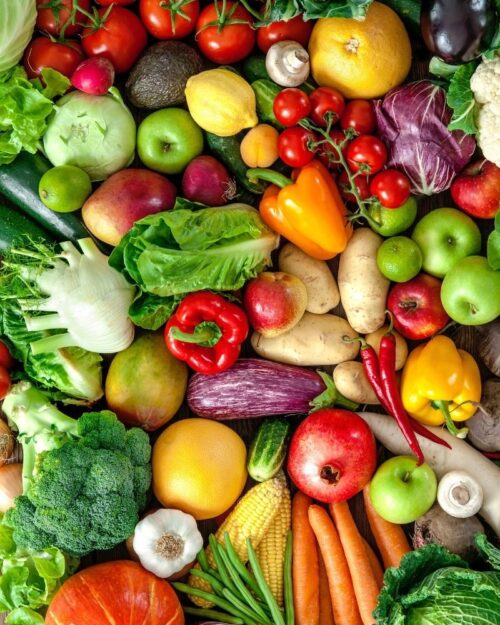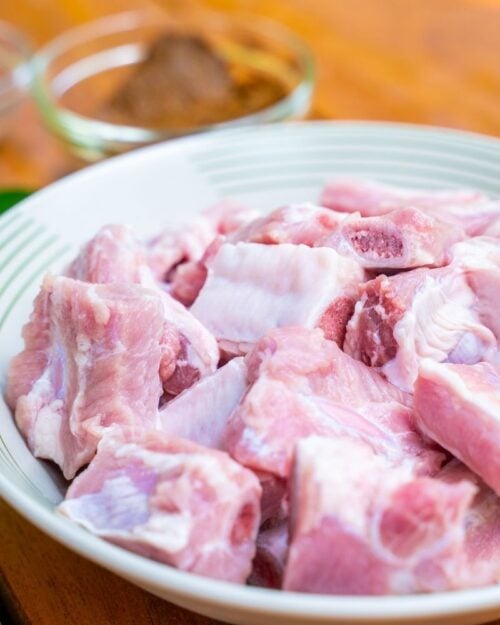What is Bone Broth?
Bone broth is often gently simmered for 24 hours (or more!) to extract as much nutrients from the bones of an animal, whether it be fish, chicken, pork or beef. The long cooking time breaks down bone to release vitamins, collagen and calcium phosphate — nutrients that are good for us. I’ve written about bone broth before, including this recipe for slow cooker bone broth.
Sure, it’s a trendy thing right now, with restaurants offering drive-through bone broth served in a coffee cup for $9, cookbooks dedicated to the art of bone broths (I highly recommend The Nourished Kitchen Cookbook which features bone broth) and even an entire line of bone broth concentrates that you can buy.

Health Benefits of Bone Broth
Bone broth is not only delicious, but really good for you! It’s great to drink and has a ton of benefits for your health, like the following:
- Supports gut health and digestion
- Contains amino acids
- Immune booster
- Anti-aging
- Good for skin and nails
What’s the difference between broth, bone broth and soups?
Generally, soups are made with meats, bones, vegetables, herbs, added grains, sometimes thickened with starches – and simmered for a couple of hours.
Broths are mostly made from meats or vegetables and left clear without very much else added. Broths are also simmered for a couple of hours, resulting in a light colored, light flavored broth.
Bone broths are cooked for a day or even longer. Your favorite Vietnamese restaurant most likely simmer their pho broth overnight, which is why the broth is so rich and flavorful.
The long cooking time extracts so many nutrients and flavor! How do you know when you’ve extracted maximum nutrients and flavor? When the bones literally disintegrate just by giving a little pressure with your fingers.

Use leftover bones and vegetables to make bone broth!
“Perpetual” Slow Cooker Bone Broth Recipe
Like Nourished Kitchen, we make our bone broth in the slow cooker, and it will last us all week long. The process starts on Sunday night, and the slow cooker will do its magic all night long.
In the morning, we’ll enjoy bone broth as part of our breakfast. Every day, I’ll top off the pot with more water and keep the slow cooker humming along.
Each day, I’ll add a vegetable, switch out for fresh herbs, throw in a couple of umami-boosting Asian ingredients.
As the days progress, the bone broth develops new flavor, gets richer, smoother, fuller. We get the benefit of the valuable nutrition that’s normally locked inside the bones.
Some days, we’ll top off the bone broth with chopped herbs, or shredded seaweed just before serving. Or a spoonful of leftover rice in the bone broth is great too.
Secrets to Clear, Clean Bone Broth
Key to bone broth – be gentle. The cooking process is slow and gentle, coaxing out flavor with very little bubbles (no violent boiling!)
Don’t stir. Especially after the first 2 days. The bones will be come very soft and will crumble if you stir the pot too vigorously, resulting in a gritty broth.
Use cheesecloth or herb/tea bags to contain any herbs, aromatics or spices that are very small (see below.) This avoids having you dig around, stir around to fish these items out.
Use a very fine mesh skimmer to skim the surface of the broth every day, especially during the first 6-8 hours. The “scum” will cloud your broth during these first few hours of cooking. What’s the scum made out of? Proteins, fats, microscopic bone fragments (especially if the bones were cut), oils, impurities. Get rid of it!
Ready for the next batch? Jumpstart your next batch with a little of the last batch of concentrated “liquid gold!” We call this “Infinite Bone Broth.” Restaurants do the same with broths, sauces and sourdough bread too. Seed the next batch with rich flavor you’ve already built.
Flavoring Bone Broth
You can change the flavor or your bone broth by including different spices, herbs, and vegetables. Some of my favorite ways to do that are by including flavor inspiration from Asian cooking so that I can use the broth to make delicious recipes like ramen or dumpling soup.
Chinese Inspired Bone Broth
Use fish bones. Include ginger, scallions, and lots of garlic.
Thai Inspired Bone Broth
Use chicken or pork. Add ginger, lemongrass, cilantro, and garlic!
Vietnamese Inspired Bone Broth
Use beef bones. Roast them ahead of time! Add spices like star anise, whole cloves, cinnamon, coriander seeds, cardamom, and fennel seeds.

Here’s how to use leftover vegetables in bone broth!
How to Use Leftover Vegetables in Bone Broth
All week long while I am cooking, I store up leftover vegetables to use in my bone broth. I keep a big leftover container in my freezer, and while I’m peeling vegetables like onions, carrots, celery, fennel, or garlic, I simply put the peels into my storage container. By the end of the week, it’s full and ready to use for broth!
You can use any combination of vegetables in your bone broth, but make sure you don’t include the following vegetables:
- Asparagus
- Broccoli
- Artichokes
- Brussels sprouts
My favorites are celery, onion, carrot, and corn.

You can use all sorts of bones to make bone broth!
What Bones to Buy to Make Bone Broth
I use all sorts of bones in my bone broth depending on what I’ve been cooking that week. This recipe is perfect for using up leftover meat that you have and any extra bones from cooking. Depending on how you are flavoring your broth, you may want to use different bones. For example, I prefer using pork or chicken bones for Chinese or Japanese style bone broth. Here’s a quick guide to which bones you can use:
- Pork Bone Broth: spareribs, neck, hock, really anything. Grass fed and organic is best!
- Chicken Bone Broth: whole, raw chicken, or just the frame of a rotisserie chicken you’ve already enjoyed. You can also use chicken wings or chicken feet. Turkey works great too. Grass fed and organic is best!
- Beef Bone Broth: oxtail, knuckle, neck, short ribs. I also use beef bone marrow as well, but after roasting, I”ll spoon out the marrow, spread it on bread and sprinkle with sea salt for a little treat. Basically, too much marrow in the bone broth will make the broth greasy tasting. Short ribs have amazing flavor — I like to add them to any beef bone broth that I make. If you’d like to use beef bones (great for Vietnamese bone broth), I suggest roasting the bones (350F for 30 minutes) first before adding them to your slow cooker. Not necessary, but it will give a richer bone broth.
- Fish Bone Broth: Fish bones and head. I like to do this traditional Chinese style with garlic, lots of ginger and green onion. Remove the fish skin and the thin, silvery lining in the gut area (very fishy taste). If the fish is raw, I prefer to roast the fish bones (350F for 20 minutes) – as this tames the fishiness smell and flavor of the bone broth. Most fish will work except for oily fish like mackerel.
The post How to Make Bone Broth appeared first on Steamy Kitchen Recipes Giveaways.
from Steamy Kitchen Recipes Giveaways https://ift.tt/3rgrN0k
via New Kitchen Special
No comments:
Post a Comment